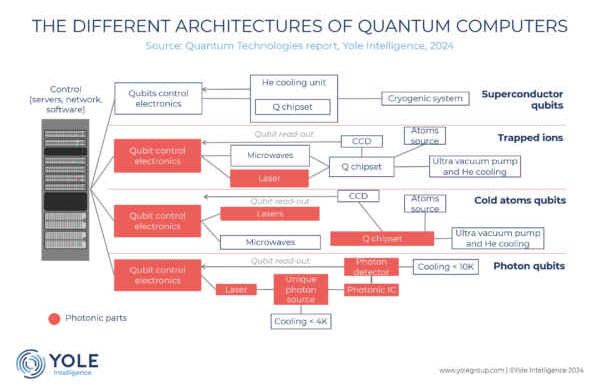Several qubit technologies continue to vie for prominence, indicating the likelihood of a diverse array of approaches coexisting in the future.
Every year witnesses the emergence of new players, with the collective hope of realizing commercial use cases in the near future.
Quantum technologies encompass computing, communication, and sensing, with quantum computing playing a pivotal role in simulation, optimisation, and AI .
While research and development efforts and investments predominantly target quantum computing, there is a growing interest in quantum networking and ultra-sensitive sensors.
“Forecasts anticipate significant growth in quantum computing hardware and QaaS , reaching US$438 million and US$528 million, respectively, by 2029,” says Yole’s Eric Mounier, “Quantum communication, propelled by QKD and QRNG , is projected to expand its market to US$249 million by the same year. Despite its niche status, quantum sensing offers precise measurement capabilities across various parameters, with a projected market value of US$617 million by 2029.”
Overall, the total quantum market is expected to reach US$1,832 million by 2029, with quantum computing poised to dominate post-2030, reaching US$3,324 million by 2034, driven primarily by QaaS.
The quantum ecosystem is advancing steadily, bolstered by collaborative research projects, patent accumulation, startup formation, and the entry of semiconductor vendors and equipment manufacturers into the fray.
However, partnerships remain crucial as only a select few can simultaneously pursue diverse R&D approaches for qubits.
Quantum market
Investment in quantum technologies, both public and private, has reached significant levels, totaling $30 billion publicly and an estimated $4 billion privately thus far.
Europe and the USA lead in quantum science investments, with the European Union being the largest public investor in quantum research. The USA benefits from substantial industry investments from tech giants like IBM, Google, Microsoft, and Intel, alongside a robust startup funding ecosystem, leveraging its domestic market size and dynamism.
The majority of these funds, approximately 75%, are directed toward quantum computing hardware, given the substantial capital requirements for its advancement.
The remainder primarily supports systems and applications software. Additionally, companies are transitioning from private financing to avenues like IPOs , mergers and acquisitions, and spin-off ventures.
However, IPOs face challenges due to the absence of short-term revenue expectations in the quantum technology sector.
Looking ahead, the success of quantum computers hinges on addressing SWaP-C concerns.
Despite the long-term nature of quantum technologies, investment opportunities are ripe today, particularly considering that technologies developed for quantum computing, such as photonics, cryogenics, RF , AP , and control electronics also hold promise in non-quantum computing applications.







